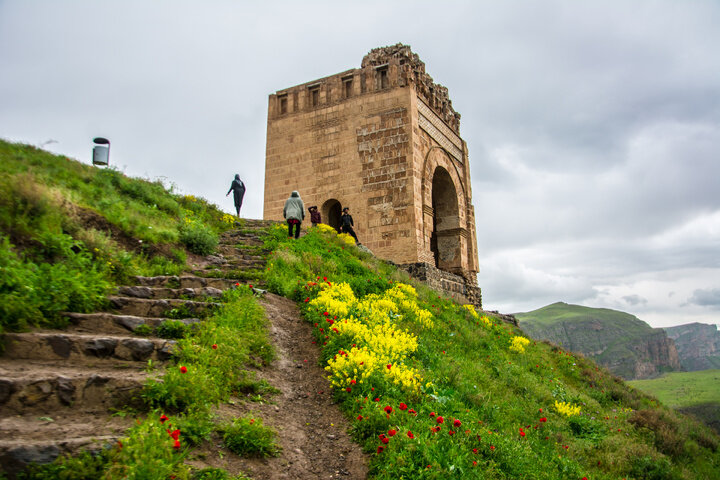INSUBCONTINENT EXCLUSIVE:
TEHRAN-- Zahhak castle in Hashtrud, East Azarbaijan province, is one of the prominent examples of rock and military architecture
It is today at the center of the restoration, research, and development-oriented programs of East Azarbaijan Cultural Heritage, Tourism, and
Handicrafts Department.Zahhak castle is planned not only to be on the course of cultural revival, however also to turn into one of the
nations cultural tourist centers, CHTN reported.Vahid Navadad, the deputy head of East Azarbaijan Cultural Heritage, Tourism, and
Handicrafts Department, stated, We plan to introduce and promote the infrastructures referring to this historical castle.Based on
stratigraphic research studies and historical documents, restorations are underway in the main entryway and eastern wing of the castle, he
said.He added that maintaining Zahhak castle means protecting part of the historical memory of the region and cultural identity of
Azarbaijan.Our method is to have minimum repair with regard to originality of products and historical form of the monolith, he mentioned.The
distinct tourist potentials of Zahhak castle can develop into among the pillars of sustainable advancement in the region, he said.Also,
Alireza Bairamzadeh, the deputy head of East Azarbaijan Tourism Department, stated Zahhak castle is not simply a place to check out, however
a lived experience: a combination of history, nature, folklore, and architecture
Our strategy is to prepare the ground for drawing in cultural travelers by enhancing gain access to paths, setting up multilingual
information boards, and establishing standard infrastructure.We are putting together ecotourism plans with participation of local
neighborhood so that tourism in this region not only leads to financial success however likewise lays the groundwork for the transfer of
We prepare specialized tours with focus on mythological and historical research studies to draw elite travelers to the region.Also, Ahmad
Hamzehzadeh, the director general of East Azarbaijan Cultural Heritage, Tourism, and Handicrafts Department, said, We see Zahhak Castle not
simply as a historic monolith, but likewise as a living asset for recreating the regions identity.Negotiations are underway for attracting
cultural financiers with the aim of introducing a museum site, implementing night tourist programs, and even developing access routes to the
Apart from preserving the historic originality of the castle, these steps can turn into a driving force for economic growth of Hashtrud and
its surrounding areas, he concluded.Zahhak Castle, called after the mythical figure Zahhak from ancient Iranian folklore, dates back to the
2nd millennium BC, with continued occupation through the Timurid era.The fortress, which includes intricate brickwork, archways, and
staircases, provides insights into ancient protective architecture and societal structures.The castles tactical significance throughout the
Parthian period is underscored by historical accounts, including its function in the defeat of Roman general Marc Antony in 37 BC.The Median
infantry, allied with the Parthian cavalry, played a vital part in this success, offering an uncommon glance into the military methods of
the era.Archaeological excavations, started by British researchers years ago, have revealed artifacts such as stucco residues with traces of
coloring, shedding light on the sites artistic and cultural heritage.Glimpses of Parthian eraThe Parthian Empire, also referred to as the
Arsacid Empire, was a major Iranian political and cultural power centered in ancient Iran from 247 BC to 224 CE
Its name originates from its creator, Arsaces I, who led the Parni people in conquering Parthia, a northeastern area of Iran
At the time, Parthia was a satrapy (province) under Andragoras, a rebel versus the Seleucid Empire.At its zenith, the Parthian Empire
extended from the northern Euphrates River (modern-day central-eastern Turkey) to contemporary Afghanistan and western Pakistan
Placed along the Silk Road, the empire thrived as a hub for trade and commerce, connecting the Roman Empire in the Mediterranean to the Han
dynasty in China.The Parthians absorbed various aspects of the diverse cultures within their empire, which included Persian, Hellenistic,
The Arsacid court embraced lots of aspects of Greek culture however gradually saw a revival of Iranian traditions
Parthian rulers embraced the title King of Kings, asserting their heritage from the Achaemenid Empire
Unlike the Achaemenids, who governed through centrally selected satraps, the Parthians typically allowed regional kings to function as
As the empire expanded, its main government moved from Nisa to Ctesiphon, near modern-day Baghdad, though other cities likewise worked as
This article first appeared/also appeared in Tehran Times

